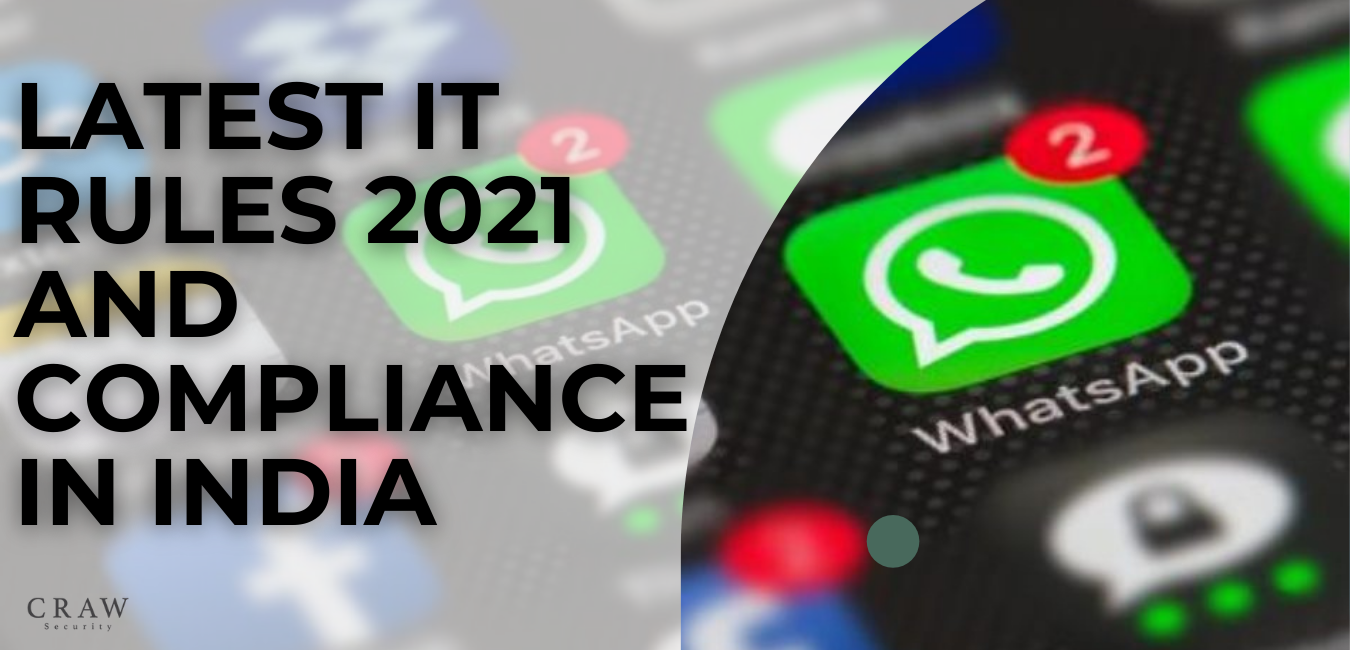Latest IT Rules 2021 AND Compliances in India

IT RULES 2021 AND COMPLIANCES 2021
DUE DILIGENCE BY INTERMEDIARIES AND GRIEVANCE REDRESSAL MECHANISM
Due diligence by an intermediary: An intermediary, including social media intermediary and significant social media intermediary, shall observe the following due diligence while discharging its duties, namely: –
- a) The intermediary should publish the content on their platform with proper rules and regulations, privacy policies, and access or usage by the person.
- b) The intermediary should inform the user about the privacy policies and agreement that they should not publish or edit the content if they don’t have the right to do so and also not to publish content like: –
➢ infringes any patent, trademark, copyright, or another proprietary right
➢ is harmful to a child;
➢ violates any law for the time being in force;
➢ contains a software virus or any other computer code, file, or program designed to interrupt, destroy or limit the functionality of any computer resource;
➢ impersonates another person;
- c) An intermediary shall periodically inform its users, at least once every year, that in case of non-compliance with rules and regulations, privacy policy, or user agreement for access or usage of the computer resource of such intermediary, it has the right to terminate the access or usage rights of the users to the computer resource immediately or remove non-compliant information or both, as the case may be;
- d) The intermediary shall take all reasonable measures to secure its computer resource and information contained therein following the reasonable security practices and procedures as prescribed.
- e) The intermediary shall, as soon as possible, but not later than seventy-two hours of the receipt of an order, provide information under its control or possession, or assistance to the Government agency which is lawfully authorized for investigative or protective or cybersecurity activities, for the purposes of verification of identity, or for the prevention, detection, investigation, or prosecution, of offenses under any law for the time being in force, or for cybersecurity incidents.
- Grievance redressal mechanism of intermediary: The intermediary shall prominently publish on its website, mobile-based application, or both, as the case may be, the name of the Grievance Officer and his contact details as well as mechanism by which a user or a victim may make a complaint against violation of the provisions of this rule or any other matters pertaining to the computer resources made available by it, and the Grievance Officer shall –
➢ Acknowledge the complaint within twenty-four hours and dispose of such
Additional due diligence to be observed by significant social media intermediary υ Appoint a Chief Compliance Officer who shall be responsible for ensuring compliance with IT Rules 2021 and Act made thereunder and shall be liable in any proceedings.
Appoint a nodal contact person for 24×7 coordination with law enforcement agencies and officers to ensure compliance to their orders or requisitions made in accordance with the provisions of law or rules made thereunder.
Publish periodic compliance report every month mentioning the details of complaints received and action taken thereon, and the number of specific communication links or parts of information that the intermediary has removed or disabled access.
A significant social media intermediary providing services primarily in the nature of messaging shall enable the identification of the first originator of the information on its computer resource as may be required by a judicial order passed by a court of competent jurisdiction.
CODE OF ETHICS AND PROCEDURE AND SAFEGUARDS IN RELATION TO DIGITALMEDIA
GRIEVANCE REDRESSAL MECHANISM
- Any person having a grievance regarding content published by a publisher in relation to the Code of Ethics may furnish his grievance on the grievance mechanism established.
- The publisher shall generate and issue an acknowledgment of the grievance for the benefit of the complainant within twenty-four hours of it being furnished for information and record.
- The manner of grievance redressal shall have the following arrangement–
(a) the publisher shall address the grievance and inform the complainant of its decision within fifteen days of the registration of the grievance;
(b) if the decision of the publisher is not communicated to the complainant within the stipulated fifteen days, the grievance shall be escalated to the level of the self–regulating body of which such publisher is a member
- SELF REGULATING MECHANISM – LEVEL I
- A publisher shall—
(a) establish a grievance redressal mechanism and shall appoint a Grievance Officer based in India, who shall be responsible for the redressal of grievances received by him;
(b) Display the contact details related to its grievance redressal mechanism and the name and contact details of its Grievance Officer at an appropriate place on its website or interface, as the case may be;
(c) Ensure that the Grievance Officer takes a decision on every grievance received by it within fifteen days, and communicate the same to the complainant within the specified time:
(d) Be a member of a self-regulating body as referred to in rule 12 and abide by its terms and conditions.
- SELF REGULATING MECHANISM – LEVEL II
- There may be one or more self-regulatory bodies of publishers, being an independent body constituted by publishers or their associations.
- The self-regulatory body shall be headed by a retired judge of the Supreme Court, a High Court, or an independent eminent person from the field of media, broadcasting, entertainment, child rights, human rights, or such other relevant field, and have other members, not exceeding six, being experts from the field of media, broadcasting, entertainment, child rights, human rights, and such other relevant fields.
- The self-regulating body shall perform the following functions, namely: —
(a) oversee and ensure the alignment and adherence by the publisher to the Code of Ethics;
(4) May issue following guidance or advisories to the publishers as under, namely: —
(a)warning, censuring, admonishing, or reprimanding the publisher
(b) requiring an apology by the publisher
(c) requiring the publisher to include a warning card or a disclaimer; or
(d) in the case of online curated content, direct the publisher
(i) reclassify ratings of relevant content;
(ii) make appropriate modifications in the content descriptor, age classification, and access control measures;
(iii) edit synopsis of relevant content;
(e) in case of any content where it is satisfied that there is a need for taking action to delete or modify the content for preventing incitement to the commission of a cognizable often
- OVERSIGHT MECHANISM – LEVEL III
(1) The Ministry shall coordinate and facilitate the adherence to the Code of Ethics by publishers and self-regulating bodies, develop an Oversight Mechanism, and perform the following functions, namely: —
(a) publish a charter for self-regulating bodies, including Codes of Practices for such bodies;
(b) establish an Inter-Departmental Committee for hearing grievances;
(c) issue appropriate guidance and advisories to publishers;
(d) issue orders and directions to the publishers for maintenance and adherence to the Code of Ethics.
2) Blocking of information in case of emergency. —
(1) Notwithstanding anything contained in rules 14 and 15, the Authorized Officer, in any case of emergency nature.
- FURNISHING OF INFORMATION
- A publisher of news and current affairs content and a publisher of online curated content operating in the territory of India shall inform the Ministry about the details of its entity by furnishing information along with such documents as may be specified, for the purpose of enabling communication and coordination.
- The information referred to in sub-rule (1) shall be furnished within a period of thirty days of the publication of these rules, and where such publisher begins operation in the territory of India or comes into existence after commencement of these rules, within thirty days from the date of start of its operations in the territory of India or it coming into existence, as the case may be.
- The publisher of news and current affairs content and the publisher of online curated content shall publish periodic compliance reports every month mentioning the details of grievances received and action taken thereon.
- The Ministry may call for such additional information from the publisher as it may consider necessary for the implementation of this Rule.
- MISCELLANEOUS Disclosure of Information. —
(1) A publisher and a self-regulating body, shall make true and full disclosure of all grievances received by it, the manner in which the grievances are disposed of, the action taken on the grievance, the reply sent to the complainant, the orders or directions received by it under these rules and action taken on such orders or directions.
(2) The information referred to in sub-rule (1) shall be displayed publicly and updated monthly.
(3) Subject to any law for the time being in force, the publisher shall preserve records of content transmitted by it for a minimum period of sixty days and make it available to the self-regulating body or the Central Government, or any other Government agency, as may be requisitioned by them for implementation of these rules.
CODE OF ETHICS
Online curated content:
(A) General Principles:
(a) A publisher shall not transmit or publish or exhibit any content which is prohibited under any law for the time being in force or has been prohibited by any court of competent jurisdiction.
(b) A publisher shall take into consideration the following factors, when deciding to feature or transmit or publish or exhibit any content, after duly considering the implications of any content as falling under the following categories, and shall exercise due caution and discretion in relation to the same, namely: —
(i) content which affects the sovereignty and integrity of India;
(ii) content which threatens, endangers, or jeopardizes the security of the State;
(iii) content which is detrimental to India‘s friendly relations with foreign countries;
(iv) content that is likely to incite violence or disturb the maintenance of public order.
(c) A publisher shall take into consideration India‘s multi-racial and multi-religious context and exercise due caution and discretion when featuring the activities, beliefs, practices, or views of any racial or religious group
(B) Content Classification:
All content transmitted or published or exhibited by a publisher of online curated content shall be classified, based on the nature and type of content, into the following rating categories, namely: — (a) Online curated content which is suitable for children, as well as people of all ages, shall be classified as ―U‖ rating;
(b) Online curated content which is suitable for persons aged 7 years and above, and can be viewed by a person under the age of 7 years with parental guidance, shall be classified as ―U/A 7+‖ rating; (c) Online curated content which is suitable for persons aged 13 years and above, and can be viewed by a person under the age of 13 years with parental guidance, shall be classified as ―U/A 13+‖ rating;
(d) Online curated content which is suitable for persons aged 16 years and above, and can be viewed by a person under the age of 16 years with parental guidance, shall be classified as ―U/A 16+‖ rating;
(e) Online curated content which is restricted to adults shall be classified as ―A‖ rating. (C) Display of Classification:
(a) The publisher of online curated content shall prominently display the classification rating specific to each content or programmed together with a content descriptor informing the user about the nature of the content, and advising on viewer discretion (if applicable) at the beginning of every programmed enabling the user to make an informed decision, prior to watching the programmed\
GENERAL GUIDELINES of IT Rules 2021 FOR CLASSIFICATION OF FILMS AND OTHER ENTERTAINMENT PROGRAMMES, INCLUDING WEB-BASED SERIALS
Context: Curated content may be considered in the light of the period depicted in such content and the contemporary standards of the country and the people to which such content relates. Therefore, the context in which an issue is presented within a film or video may be given consideration. Factors such as the setting of a work (historical, fantasy, realistic, contemporary, etc.), the manner of presentation of the content, the apparent intention of the content, the original production date of the content, and any special merits of the work may influence the classification decision.
Theme: Classification decisions may take into the theme of any content but will depend significantly on the treatment of that theme, especially the sensitivity of its presentation. The most challenging themes (for example, drug misuse, violence, pedophilia, sex, racial or communal hatred or violence, etc.) are unlikely to be appropriate at the junior levels of classification.
Tone and impact: Curated content may be judged in its entirety from the point of view of its overall impact. The tone of content can be an important factor in deciding the influence it may have on various groups of people. Thus, films/serials that have a stronger depiction of violence may receive a higher classification.
Target audience: The classification of any content may also depend upon the target audience of the work and the impact of the work on such an audience
ISSUE RELATED GUIDELINES IT Rules 2021
Discrimination: The categorical classification of content shall take into account the impact of a film on matters such as caste, race, gender, religion, disability, or sexuality that may arise in a wide range of works, and the classification decision will take account of the strength or impact of their inclusion.
Psychotropic substances, liquor, smoking, and tobacco: Films or serials, etc. that as a whole portray misuse of psychotropic substances, liquor, smoking, and tobacco would qualify for a higher category of classification.
Imitable behavior:
1) Classification decisions may take into account any portrayal of criminal and violent behavior with weapons.
(2) Portrayal of potentially dangerous behavior that is likely to incite the commission of any offense (including suicide, and infliction of self-harm) and that children and young people may potentially copy, shall receive a higher classification.
(3) Films or serials with song and dance scenes comprising lyrics and gestures that have sexual innuendos would receive a higher classification.
Language:
(1) Language is of particular importance, given the vast linguistic diversity of our country. The use of language, dialect, idioms, and euphemisms vary from region to region and are culture-specific. This factor has to be taken into account during the process of classification of work in a particular category.
(2) Language that people may find offensive includes the use of expletives. The extent of the offense may vary according to age, gender, race, background, beliefs, and expectations of the target audience from the work as well as the context, region, and language in which the word, expression, or gesture is used.
(3) It is not possible to set out a comprehensive list of words, expressions or gestures that are acceptable at each category in every Indian language. The advice at different classification levels, therefore, provides general guidance to consider while judging the level of classification for content, based on this guideline
(e) Nudity:
(1) No content that is prohibited by law at the time being in force can be published or transmitted. (2) Nudity with a sexual context will receive a higher classification of ―A‖.
(f) Sex: No content that is prohibited by law at the time being in force can be published or transmitted. The classification of content in various ratings from U/A 16+ to ―A‖ shall depend upon the portrayal of non-explicit (implicit) to the explicit depiction of sexual behavior.
(g) Violence: Classification decisions shall take account of the degree and nature of violence in a work.





